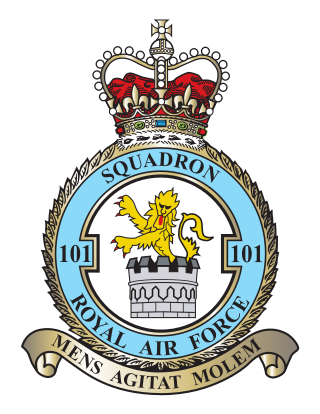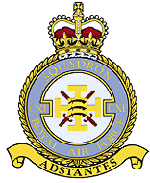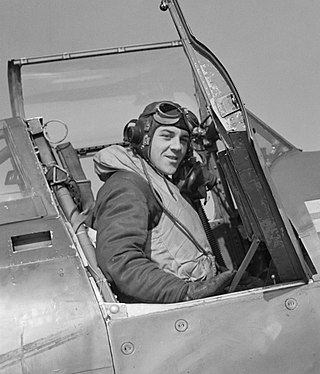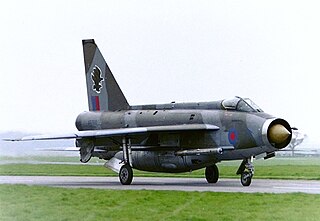
The Red Arrows, officially known as the Royal Air Force Aerobatic Team, is the aerobatics display team of the Royal Air Force (RAF) based at RAF Waddington. The team was formed in late 1964 as an all-RAF team, replacing a number of unofficial teams that had been sponsored by RAF commands.

The English Electric Lightning is a British fighter aircraft that served as an interceptor during the 1960s, the 1970s and into the late 1980s. It was capable of a top speed of above Mach 2. The Lightning was designed, developed, and manufactured by English Electric, After EE merged with other aircraft manufactures to form British Aircraft Corporation it was marketed as the BAC Lightning. It was operated by the Royal Air Force (RAF), the Kuwait Air Force (KAF), and the Royal Saudi Air Force (RSAF).

Number 617 Squadron is a Royal Air Force aircraft squadron, originally based at RAF Scampton in Lincolnshire and currently based at RAF Marham in Norfolk. It is commonly known as "The Dambusters", for its actions during Operation Chastise against German dams during the Second World War. In the early 21st century it operated the Panavia Tornado GR4 in the ground attack and reconnaissance role until being disbanded on 28 March 2014. The Dambusters reformed on 18 April 2018, and was equipped at RAF Marham in June 2018 with the Lockheed Martin F-35B Lightning, becoming the first squadron to be based in the UK with this advanced V/STOL type. The unit is composed of both RAF and Royal Navy personnel, and operates from the Royal Navy's Queen Elizabeth-class aircraft carriers.

Number 5 Squadron was a squadron of the Royal Air Force. It most recently operated the Raytheon Sentinel R1 Airborne STand-Off Radar (ASTOR) aircraft from RAF Waddington, Lincolnshire, between April 2004 until March 2021.

Surya Kiran is an aerobatics demonstration team of the Indian Air Force. The Surya Kiran Aerobatic Team (SKAT) was formed in 1996 and are a part of the 52nd Squadron of the IAF. The team has since performed numerous demonstrations usually with nine aircraft. The squadron was composed of the HAL HJT-16 Kiran Mk.2 military trainer aircraft till 2011 and were based at the Bidar Air Force Station in Karnataka. The team was suspended in February 2011 and was re-established with Hawk Mk-132 aircraft in 2017.

No. 101 Squadron of the Royal Air Force operates the Airbus Voyager in the air-to-air refuelling and transport roles from RAF Brize Norton, Oxfordshire.

No. 303 Squadron RAF, also known as the 303rd "Tadeusz Kościuszko Warsaw" Fighter Squadron, was one of two Polish squadrons that fought during the Battle of Britain along with No. 302 Squadron, of 16 total Polish squadrons in the Royal Air Force (RAF) during the Second World War. Flying Hawker Hurricanes, the squadron claimed the largest number of aircraft shot down of the 66 Allied fighter squadrons engaged in the Battle of Britain, even though it joined the fray two months after the battle had begun.

Number 111 (Fighter) Squadron, also known as No. CXI (F) Squadron and nicknamed Treble One, was a squadron of the Royal Air Force. It was formed in 1917 in the Middle East as No. 111 Squadron of the Royal Flying Corps during the reorganisation of the Egyptian Expeditionary Force after General Edmund Allenby took command during the Sinai and Palestine Campaign. The squadron remained in the Middle East after the end of the First World War until 1920 when it was renumbered as No. 14 Squadron.

Wing Commander Roland Prosper "Bee" Beamont, was a British fighter pilot for the Royal Air Force (RAF) and an experimental test pilot during and after the Second World War. He was the first British pilot to exceed Mach 1 in a British aircraft in level flight (P.1A), and the first to fly a British aircraft at Mach 2 (P.1B).
Bruce Barrymore Halpenny was an English military historian and author, specializing in airfields and aircraft, as well as ghost stories and mysteries. He was also a broadcaster and games inventor.

Royal Air Force Binbrook or RAF Binbrook was a Royal Air Force station, now closed, located near Binbrook, Lincolnshire, England. The old domestic site has been renamed to become the village of Brookenby. RAF Binbrook was primarily used by Bomber Command in the Second World War. The Central Fighter Establishment moved to Binbrook from RAF West Raynham between 1959 and 1962 and two English Electric Lightning squadrons were stationed there between 1965 and 1988.
Peter Guy Ottewill was an English RAF officer who during the Second World War in 1943 rescued two airmen from a Bristol Beaufighter which had crashed into an ammunition store at RAF Kirknewton during take-off, and was awarded the George Medal.
Samlesbury Aerodrome is a disused airfield at Balderstone near Samlesbury and Blackburn in Ribble Valley district of Lancashire. The aerodrome is owned by defence company BAE Systems which uses the site for the manufacture of several different aircraft. Currently the company employs approximately 3,000 people at the site. The aerodrome is part of Lancashire Enterprise Zone.
Captain William Schaffner was a pilot in the United States Air Force. He disappeared, presumed dead, flying a BAC Lightning over the North Sea while on exchange with the Royal Air Force.

Number 601 Squadron is a squadron of the RAF Reserves, based in London. The squadron took part in the Battle of Britain, during which the first Americans to fly in World War II were members of the squadron.

The English Electric Canberra subtitled The History and Development of a Classic Jet (ISBN 978-1-84415-242-1) is a book by British military historian and author Bruce Barrymore Halpenny about the English Electric Canberra. Illustrated throughout, the book includes interviews with Wing Commander K H Wallis, the man Halpenny attributes as having "saved the Canberra".
Squadron Leader John Crampton was a British pilot who conducted spy flights into the Soviet Union in the early 1950s.

The Mignet HM.14Flying Flea is a single-seat light aircraft first flown in 1933, designed for amateur construction. It was the first of a family of aircraft collectively known as Flying Fleas.

On 22 July 1966 Walter "Taffy" Holden, an engineer in command of No. 33 Maintenance Unit RAF with limited experience flying small single-engine trainer aircraft, inadvertently engaged the afterburner of a Mach 2.0-capable English Electric Lightning during ground testing. Unable to disengage the afterburner, Holden ran down the runway, narrowly missing a crossing fuel bowser and a de Havilland Comet taking off, before taking off himself. Flying without a helmet or canopy, the ejection seat disabled, and the landing gear locked down, Holden aborted his first two landing attempts. He landed on his third approach, striking the runway with the aircraft's tail as he adopted in his landing technique of a taildragger aircraft. The aircraft returned to service, and was subsequently acquired by the Imperial War Museum Duxford.














